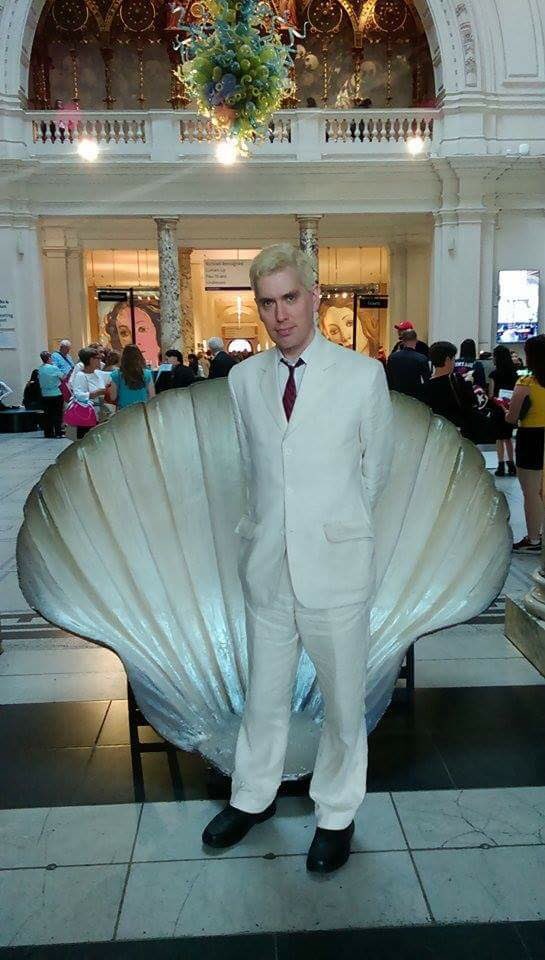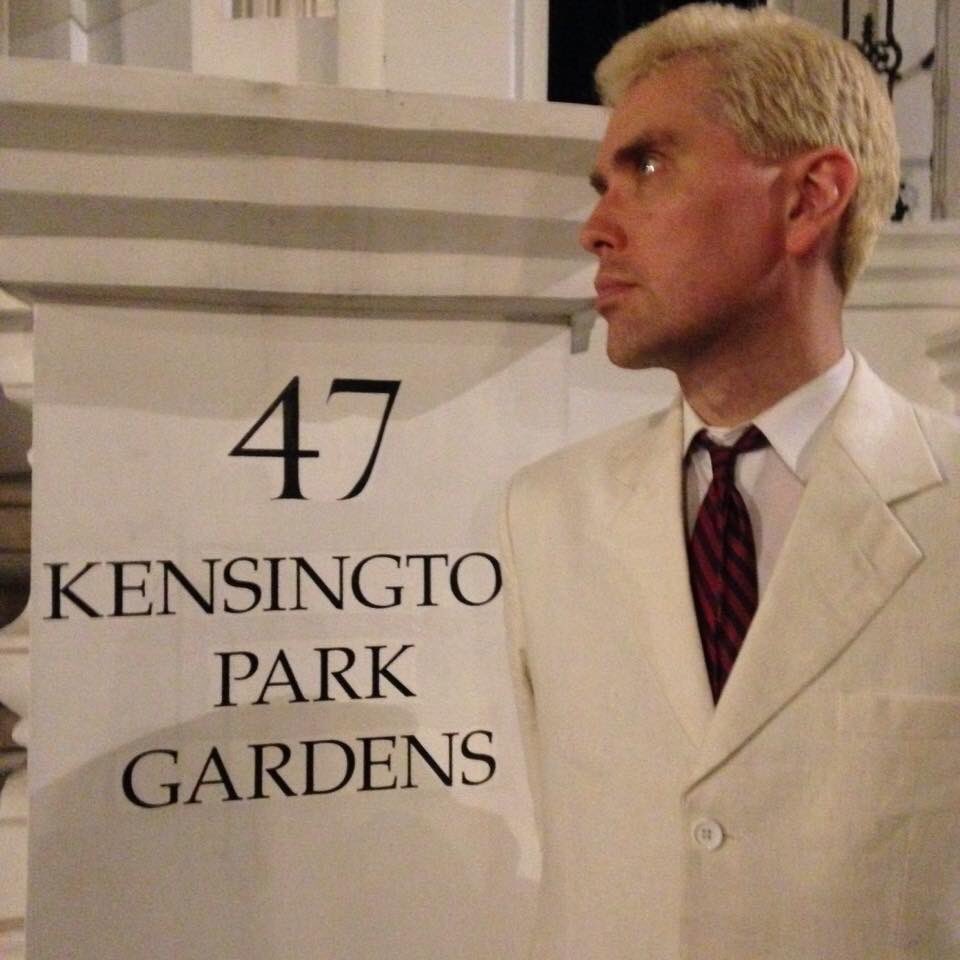Thursday 25th August 2016. London in hot weather. World of Shorts. And it is mainly men who go for shorts, too. Of the couples I see out today, it’s often the case that he is in shorts, but she is in trousers.
***
Notes on fragile masculinity. I buy some Boots No 7 moisturiser, and go for the version ‘For Men’. I do so because the box assures me it is specially made to accommodate stubble. When I get home, I realise it differs from the version for women in a more obvious way. The distaff moisturiser comes in a glass pot, which one simply opens up and dips one’s finger into. The men’s one, however, comes in a squat black pump with a spout. One has to push down hard on the spout until the moisturiser puts in an appearance. It is the most strenuous part of my daily routine. I feel like going on Dragon’s Den and pitching a moisturiser for men like me. Working title: Sissy No 7.
***
At the Thameslink section of Kentish Town station, I spot a security pass left on the platform. It looks like a fairly heavy duty one, with a thick magnetic base and a photo. The owner is a trader at Goldman Sachs. I’m about to hand it to the staff at the barriers, when I remember how long it’s taken for me in the past to retrieve possessions lost on the tube. Sometimes several weeks, including a trip to that great cave of abandoned umbrellas, the Baker Street Lost Property office.
The next day, propelled by the vanity which underscores so many good turns, I Google the trader’s name and call him at the Goldman Sachs office in Fleet Street. He says he does indeed want the pass back, and as soon as possible, and is very grateful. I tell him I’ll drop it off at his reception.
This proves to be slightly harder that I’d envisioned. To paraphrase Lord of the Rings, one does not simply walk into Goldman Sachs. They are one of those international corporations who exist in such a lofty world, they do not even announce their presence on the street. You have to know whose anonymous plate glass doors those are on Fleet Street, the ones with a security guard on the outside, standing on the street, as well as two further guards on the inside. And that’s before you even get near the reception desk. Such security is highly styled, too: large young men in large black suits, topped off with those earpieces with little coiled cables vanishing into the collar. It’s fair to say that when I arrive, I am viewed with suspicion.
I state my intention to the man on the street, doing my utmost to assure him that I am not some anti-capitalist activist, despite my slightly interesting hair. I am not trying to do a Michael Moore. Or, more recently, a Russell Brand. The guard is not convinced.
‘You can’t just… drop…  something off here.’
But then I tell him that my package, such as it is, is merely one of their own passes, at which he lets me through the revolving doors. Then the two other security men standing inside challenge me, and I have to start my story again.
The receptionist gets a third version of my tale. She won’t let me leave the pass with her either, and insists on picking up the phone and trying to call the trader in question, to get him to come down. This takes some minutes before she says, ‘He isn’t available’. By this point I’m getting flustered, and am determined not to go away still clutching the wretched thing. So I grab a scrap of paper from my bag, write out my contact details, and give it to her along with the pass. She takes it from me with an expression of pure reluctance, as if I’d just handed her a pair of my underpants. But she does take it, and the pass, and I leave.
I had hoped to feel a wave of sainthood from this episode, but instead I just feel vaguely punished.
***
Saturday 27th August 2016. Mum in town for the day. We visit the exhibition Missoni Art Colour at the Fashion and Textile Museum in Bermondsey. En route to the Museum, we get a little lost navigating the endless building works between London Bridge station and Guy’s Hospital. Many hoped-for shortcuts are closed off by the ubiquitous men in hard hats.
When passing such sites, my hope is always that the construction is for the public good, rather the private greed. Yet too often one looks up past the rising number of beggars sitting on the pavement – the other worrying side of London – to see a sign for luxury apartments. The redundancy of the word ‘luxury’ presumably lost on the developers. In Highgate, council letters alerting residents to disruptive planning permissions are becoming more frequent. Invariably, these are for private basement extensions. I’m so tempted to write in the comments, ‘Please ask the owner if the phrase, ‘I have enough’ has ever troubled their consciousness.’
At the Missoni show, the centrepiece is a display of decades of Missoni clothes, on some fifty or so mannequins, arranged on the steps of a pyramid. A number of them remind me of the Redford film of The Great Gatsby; a 1970s take on the 1920s.
Around the manniquins hang a selection of Ottavio Missoni’s abstract wall hangings, which are rather like the patchwork quilts Mum specialises in. Plenty of brightly coloured zigzags and stripes on show, as per the Missoni reputation. There’s also a small collection of postwar abstract paintings, by way of illustrating the label’s influences. One canvas stands out, ‘Spatial Structure in Tension’ (1952) by Nino Di Salvatore, a harmonious pattern of intersecting geometric shapes. Brightly coloured, of course.
Unusually, the museum allows photographs to be taken, and we regret not bringing our own devices. We are the only ones not taking photos. The shop sells a tote bag with the motto, ‘I Knit So I Won’t Kill People’.
Then to the new Tate Modern extension, Switch House. The main TM building has accordingly been renamed Boiler House. Switch House dwarves the original building, and includes a viewing platform at the top, where one can look down on the Tate Members bar. And indeed, right into the flats of the neighbouring tower blocks to the south. The north view across the Thames is stunning, however, with St Paul’s directly ahead.
We finish off with the BP Portrait Award at the NPG, which is packed. The usual prominence of family members and friends as subject matter, which I always find touching. We both like Karina In Her Raincoat, by Brian Sayers, where the coat dominates the frame. It should have won.
***
Monday 29th August 2016. To the Museum of London for the exhibition Fire! Fire!, which marks the anniversary of the Great Fire of London. It’s an extensive and spacious display, and is very much aimed at families. Lots for children to do: flaps to lift, buttons to press, clothes to dress up in, and at the end a set of wooden building blocks on a large table, with which to rebuild the razed capital. The children I see seem particularly drawn to the blocks, which I find cheering. How I miss that childhood capacity to happily build and make things, solid things, from blocks to Lego. Resentment was reserved for tidying one’s room, or writing thank you letters, or going to bed early. Never for making things.
I suppose my creative play these days is writing. The trouble is I subscribe to the Dorothy Parker quote, only enjoying writing when it’s finished, and resenting it when I’m doing it.
***
Evening: to the Barbican to see the film David Brent – Life on the Road. I was such an admirer of Mr Gervais’s series The Office. I loved how it took the TV sitcom format into a new phase, playing with the trend for docu-soaps and reality TV, while updating the eternal comedic themes of delusion and embarrassment. It was also one of the few British comedies to be successfully adapted in the US. Americans do social awkwardness too, just on a wider frequency: a more open and expressive kind of cringing. And of course, they do it through a lot more episodes.
Well, sadly, the golden touch of Ricky Gervais has manifestly dimmed. This belated big screen spin-off featuring the main character from the British Office isn’t a patch on either of the two TV series. Admittedly, there’s one or two funny moments, and Gervais’s performance is still entertaining enough – I love how his jaw hangs open when he’s annoyed. But the overall impression is that the character has simply run out of mileage.
It doesn’t help that none of the other characters from The Office are here: no Tim, Dawn or Gareth, not even a cameo from Stephen Merchant. Perhaps this was a deliberate move to resist the current vogue for reuniting old cast members as if they were rock bands (Cold Feet being the latest TV series to do this). Regardless, this new film proves that The Office was a classic because of the ensemble, not just the frontman.
***
Wednesday 31st August 2016. Filming in Meard Street for some sort of documentary. I say a few words about dandyism in front of Sebastian Horsley’s old flat. Barima Edusei is with me, having invited me along when I bumped into him on the tube the other day. GQ and River Island are apparently involved, though I get the sense that my existence is as baffling to them as theirs is to me. Still, I use my phrase about a dandy being in ‘a subculture of one’, which I’m reasonably proud of.
Later on I’m back in the British Library reading an essay by Michael Bracewell. He uses the word ‘dandy’ to describe the singer with The Fall, Mark E Smith. Much as I admire his music, the unremarkably-dressed Mr Smith wouldn’t be in my own list of examples of dandies. Still, it shows how elastic the term can be.
***
Friday 2nd September 2016. Dennis Cooper has commented on the documentary Author: The JT LeRoy Story. I remember that at the time the ‘hoax’ was exposed, he shrugged and said something along the lines of ‘sometimes it’s okay to be fooled’. This was very good of him, given he was one of the writers used as stepping-stones for LeRoy / Laura Albert’s rise to literary fame.
In his blog though, he’s changed his tune: ‘I really hated [Author]. It’s a totally superficial whitewash that treats Laura Albert like she’s some kind of kooky folk hero instead of as the psychopathic, destructive user that she is. I regret allowing the director to interview me for it.’ (from the P.S. section of denniscooperblog.com, entry dated 29 August 2016).
I don’t think Author is a whitewash entirely: there’s several times when Ms Albert goes on the defensive, at the cost to her credibility. Her compulsion to record all her private phone calls is hardly a loveably ‘kooky’ trait either. But I’m fascinated with the way this shows how documentaries seduce the viewer into swallowing one version of the truth, one which its own interviewees might disagree with.
The analytical rule about asking ‘who gets to speak’ should also include ‘who gets to speak, but wishes they hadn’t?’
***
Saturday 3rd September 2016. My 45th birthday. I have a tradition of spending my birthday going somewhere I’ve not been before. Some location I’ve always meant to visit, but never got around to. Birthdays do come around, as much as we’d like them not to. So I mollify the unpleasant reminder that one is even older, with a celebration of still being alive at all. If your eyes still work, give them new sights to look at. If your legs still work, walk to somewhere you’ve never been before. Above all, give thanks.
Today I get around to visiting Ruislip Lido. Which is really a large lake which was once a reservoir, with woodlands at one end and a beach at the other. Except the beach is more of a huge artificial sandpit doing an impersonation of a beach. The water is usually not clean enough to swim in, as indicated by a red flag outside the beach café. Children can still splash about on land, though: the beach has a large area of playground equipment, with a couple of water jets in the shape of animals.
I have breakfast in the café, then take a journey on the Ruislip Lido Railway, ‘Britain’s Longest 12 Gauge Railway’. It travels through the woods and around to the other side of the lake, ending at the Turntable Tea Room near the main road. The Tea Room has its own toy railway that whizzes around the walks. So I step off a small train to meet an even smaller one.
There’s something spooky yet attractive about cafes built to serve miniature railways: I think of the one at Dungeness, where Derek Jarman would go for fish and chips.
***
Afternoon: to Somerset House with Atalanta K, Debbie Smith and Soirai, for the exhibition Bjork – Digital.
The Bjork exhibition is a good example of first rate content hampered by its presentation. Â Visitors are herded from room to room on a timed basis, and are told to put on virtual reality headsets at each stage. All very well, except that sometimes the headsets don’t work, or they flicker on and off, or it’s not clear how to use them. Too bad if this happens, as one is soon marshaled out into the next room, and can’t come back to try again.
In one of the rooms, I stand with the VR headset on for a full minute looking at a square oblong which doesn’t seem to be doing much. It’s only then that I realise this is actually the menu screen of the software. I have to turn my head around within the digital world to see Bjork standing behind me, singing away while rendered as a glittering CGI moth goddess. I do my best to move around and enjoy the show, but am a little hampered by fears of throttling myself with the cable.
It also doesn’t help that two rooms of ‘interactive’ instruments are just sitting there, without captions or instructions of any kind. As it is, I don’t want to ‘interact’ musically with Bjork anyway. Too much like audience participation. Or Tom Sawyer and the white fence.
The best exhibits are ‘Black Lake’, where one doesn’t have to wear headsets at all. A split-screen video of the singer is projected across two opposite walls of a black room, with a surround-sound audio track encouraging you to approach different walls at different times. The other highlight is ‘Stonemilker’, where the VR world is a real Icelandic beach. You can turn fully around on the beach, and look up and down. Bjork splits into several clones of herself while dancing around you on the shingle.
Despite the Digital title of the show, the attached gift shop mainly sells Bjork’s back catalogue on vinyl. I haven’t succumbed to buying one of the new post-digital (and affordable) turntables just yet; I like the convenience of iTunes too much. But only on vinyl does one truly see that Bjork’s album sleeves are artworks in their own right.
***
Evening: My plans for a vegetarian meal for Team Bjork take a knock when the Coach and Horses in Greek Street closes its kitchen unexpectedly. We try Mildred’s in Lexington St, but it’s rammed full. To make things worse, it is now pouring with rain. I have my linen trousers drenched in Lexington Street when a passing car hits a puddle.
But things improve. Debbie takes a chance on Jane-Tira, a Thai street food place at 28 Brewer Street, which turns out to be perfect. Not too packed, friendly staff, delicious food. And my trousers dry quickly, barely leaving a mark. Either London rainwater is cleaner than one thinks, or my suit really is like the one in The Man In The White Suit.
Afterwards, a short spell in The Friendly Society (pleasant kitschy night spot, but too busy), then to the Curzon Soho downstairs bar for a quiet after dinner drink. It must be one of the few places in central London where one can go on a Saturday night and (a) sit down, (b) get a drink without queuing, and (c) hear oneself think. As long as it’s before 11pm.
A present from Debbie and Atalanta: Carl Wilson’s book Let’s Talk About Love: Why Other People Have Such Bad Taste. The title is after the Celine Dion album. Looks fun, and might well be useful for my MA research into taste, kitsch and camp.
***
Sunday 4th September 2016. To Strawberry Hill House near Twickenham, with Fenella Hitchcock. Another one of those day trips on my To Do list. The visit necessitates a train from Waterloo into Zone 5, taking thirty minutes or so. Then a short walk through some immaculately tidy suburban streets, and past St Mary’s University, which looks more like a modern upper school.
Again, I’m driven by ideas of taste. Strawberry Hill was the Georgian home of Horace Walpole, author of The Castle of Otranto, which he had remodelled into an ostentatious Gothic Revival palace. The visit comes with a pocket guide that rather neatly quotes Walpole’s own guide, but then augments his text with modern postscripts. Most of the time, the commentary is about what objects and paintings used to be there, until a grand auction in the 19th century. But the architecture and restored décor is more than enough for a visit, with cathedral-like fireplaces and ceilings, trompe l’oeil wallpaper, and best of all the crimson damask walls in the long, red and gold Gallery.
***
Monday 5th September 2016. I finish Nutshell, the new novel by Ian McEwan. It’s a high concept work, doubly so. Not only is it a tale told from the point of view of an unborn foetus, but the tale in question is a contemporary retelling of Hamlet. Gertrude becomes the pregnant ‘Trudy’, while bad uncle Claude becomes Claude the ruthless London property developer.
One of the archer pleasures of the book is that the foetal narrator has an impossibly educated and snobbish voice, commenting with expert knowledge on the quality of the wine he ingests in utero, via Trudy. The only jarring moment is when one passage betrays the author’s position on the issue of today’s students. The narrator views them as obsessed with fluid identities and un-fluid offensiveness, and goes into an extended rant that only makes sense if it’s the author, rather than his character:
‘A strange mood has seized the almost-educated young… They’re on the march, angry at times, but mostly needful, longing for authority’s blessing, its validation of their chosen identities… If I turn out to be white, I may identify as black… Offended, I enter a state of grace. Should inconvenient opinions hover near me, I’ll be in need of the special campus safe room… Let poverty go begging and climate change braise in hell. If my college does not validate me, I’ll press my face into the vice chancellor’s lapels and weep. Then demand his resignation… Feeling is queen. Unless she identifies as king.’
All very witty and topical. He’s entitled to his stance, of course, but I wish that Mr McEwan hadn’t come down on the side of the Grumpy Old Novelists. Too easy, too obvious. Regardless, whatever one’s position on the matter, this section demonstrably smacks of a lack of research, and that is not like Mr McEwan at all. If Nutshell was a debut novel from an unknown author, I suspect the publisher would recommend cutting this section altogether.
But that’s my only reservation. Elsewhere, I like his summation of reasons to stay alive to the end of the 21st century, viewing the world as one great gripping narrative:
‘Will its nine billion heroes scrape through without a nuclear exchange? Might Islam dip a feverish extremity in the cooling pond of reformation?’
It’s as good a message for turning 45 as any. Wanting to find out what happens next.
Tags: author, bjork, david brent life on the road, dennis cooper, Fashion and Textile Museum, ian mcewan, JT LeRoy, Missoni Art Colour, museum of london, ruislip lido, somerset house, tate modern










